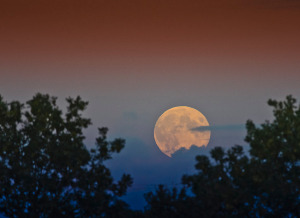Tracking the Full Moons of Autumn in Wisconsin

by Ayelen Flores, age 12
In the fall season, Wisconsin has one of the best skies to view at night. During this season, the skies are clear and the weather is cool and it is the best time to go stargazing. When the autumn moons light up the dark night for farmers and hunters, many people use the moon to keep track of fall events.
A way to monitor the moon is to remember that there are at least twelve full moons each year. Every full moon has its own unique nickname and is easy to spot and track.
The “Harvest Moon.” is the full moon that happens during September and sometimes October. This full moon is the closest to the autumnal equinox, which is when that the sun shines on the equatorial pathway. This moon got its name because it refers to an annual period in which farmers harvest crops and hunters gather food for the winter.
The full moon of October is commonly known as the “Hunter’s Moon.” Sometimes it is called the “Harvest Moon,” along with other names such as the Blood Moon, the Sanguine Moon, the Travel Moon, and the Dying Grass Moon. The origin of the name “Hunter’s Moon” came from a time in history when people that were in the Northern Hemisphere would prepare for winter by hunting and gathering.
November’s moon is refered to as the “Beaver Moon.” Other uncommon names for this moon are the Frost Moon, the Trading Moon, the Snow Moon, and the Mourning Moon. “Beaver Moon” refers to the 17th century, when French explorers, early colonists, and Native Americans would cut fur from beavers to keep warm in the winter time. All these people got beaver fur by placing traps. Also during this time, beavers would become more active, making them easier to catch.
These three moons have several unique names, along with fascinating backstories. Most importantly, these are the Moons of Fall.
[Sources: Madison.com; Wausau Daily Herald; Wisconsin Historical Society]



Loading Comments...